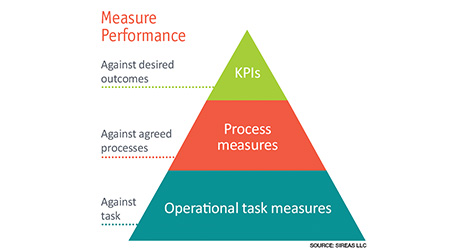The Future of Outsourcing: Better Collaboration, Strategic Relationships
First of a two-part article on how to move to strategic outsourcing relationships.
Over the past 25 years, outsourcing has become a widely used strategy in corporate real estate and facilities management. But there is often a sense among both service providers and facility management organizations that these outsourcing arrangements aren’t working as well as they might. Frequently, there is a misalignment of expectations in transaction-based outsourcing.
Clients claim to want innovation, strategy, and vision, yet deals are structured to focus solely on cost containment and tactical performance. Providers sell strategy, innovation, and leverage, but often are hampered by the very real challenge of attracting and retaining talent and the need to invest significantly in technology and global delivery platforms over an extended period. They also are handicapped by relatively short-contract terms that do not promote investment, and very rigid service level agreements that limit the ability for creativity and innovation.
The future of successful strategic outsourcing in facility management depends on the development of more extensive collaboration — to align not only expectations, but also interests. The relationship between service providers and the facility management organizations will need to be far more of a true partnership as opposed to the traditional client-provider relationships seen over the past decade.
Taking the next step
In transaction-based outsourcing, a supplier is paid based on the number of transactions executed on behalf of the client. As services and resources become more integrated and relationships more complex, organizations often move into an outsourcing model called relational outsourcing. Relational outsourcing is increasing in demand and is a more strategic outsourcing relationship that requires partnership and trust. Relational outsourcing recognizes Nobel laureate John Nash’s equilibrium theory that cooperation, not competition, guarantees the best results for all parties when establishing business and outsourcing relationships.
Relational outsourcing models typically involve a preferred provider approach with integrated processes within one functional area. This approach most typically utilizes a performance-based and managed-service delivery model or a Vested approach. Relational outsourcing models typically are most beneficial when developed with a long-term relationship between provider and client as a goal. As a result, organizations (both providers and clients) need to be mindful in their selection of a partner and incorporate more value-add elements in the relationships. These might include development of a shared vision, definition of shared success such as a focus on innovation, and equitable sharing of both the risks and the rewards. Service providers will need to become strategic partners and intimately involve themselves in the organization’s strategic planning. Perhaps most critical, relational outsourcing requires mutual trust and desire to build a long-term relationship.
Among the mutually beneficial characteristics of an effective relational outsourcing model:
• KPIs are linked directly to compensation for both parties, so that all participants are rewarded for mutual success. Facility managers must recognize that success will result in a payment to the supplier, and plan for that in the budget.
• Recognition that there is a difference between critical success factors (cause of success — what must be done to be successful), key performance indicators (effects of actions), and discretionary metrics (typically not customer focused — things like client relationship management).
• Scorecard structures that are flexible, enabling weights to vary so focus can shift based on critical priorities.
• Discretionary measures that include “softer” but critical issues, such as “relationship management.”
• A clear definition of what is being measured, how it is calculated, and who gathers and reports the data.
• Operational measures are handled at the operational level — not at the contract level.
Relational requirements have generated new collaborative contracting models in the industry. One of these is the performance-based and managed service delivery model. This model is outcome-based and is structured to effectively measure and align mission, vision, and performance, and is linked directly to the desired outcomes. By definition, success requires cross-company coordination within both supplier and client. It is imperative to measure each organization’s processes, behaviors, and outcomes. A well-developed performance-based and managed service delivery model limits the number of metrics and measures to focus instead on impact, and requires a multi-level approach to measurement of performance. Not all metrics are KPIs. Performance should and can be measured at the strategic, process, and operational levels. The metrics, measurement, and management of performance will differ for each level.
Consider repairs and maintenance. An operational task would be measured based upon the repair of a specific asset, a process measure would be focused on how repair and maintenance is performed across the portfolio, and a KPI might be the preventive maintenance plan that identifies the maintenance required so a repair is not necessary at all.
Related Topics:









